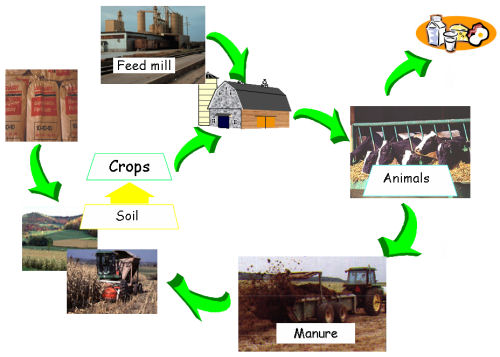What is Whole Farm Nutrient Balance?
Nutrient management is a process of planning for manure and fertilizer applications to individual crop fields. Whereas whole farm nutrient balance considers the location and flow of nutrients onto, within and off the entire farm. Whole farm nutrient balance involves taking a step back and also comparing the amount of nitrogen (N), phosphorus (P), and potassium (K) and other nutrients entering the farm as purchased feed, fertilizer, animals etc. with the amount of nutrients leaving the farm as milk, animals, crops, manure exports to other farms, etc. Such a comparison can help in determining the economic and environmental impacts of nutrient management on dairy and livestock farms.
A comparison of the flows of nutrients onto and off dairy and livestock farms results in whole farm nutrient balance assessment. This balance is usually calculated from records of the nutrient-containing materials coming onto the farm (feed, fertilizer, purchased animals) and those leaving the farm in the form or products (milk, meat, eggs, crops, etc.). Balances can be expressed as percentage remaining, lbs/acre remaining or, for dairy farms, as lbs remaining per unit milk produced. For an example, see the Cornell Whole Farm Nutrient Balance Software or other such tools.
An estimate of the whole farm nutrient balance can also be determined from the density of livestock on the farm. Animal Density is usually estimated from the number of animal units per acre. (See box below)
Animal Density=Animal Units (AU)/Acre on an annualized basis,
Animal Density=AU/Acre*(Days/365) Go to the Animal_density_Calculator (Excel file) |
Why Is the Whole Farm Nutrient Balance Important?
When the inflow of nutrients is greater than the outflow, annual losses and/or accumulation of nutrients will occur. The whole farm nutrient balance can indicate the potential for non-point source pollution from nutrients on the farm which can help to target management efforts to minimize the impact of nutrients on the environment. As such, the assessment of a farm’s nutrient mass balance can assist producers in determining the need for and identification of management practices that can reduce nutrient imports or enhance exports such as off site movement of manure, manure treatment, feed ration adjustments, land purchases and herd size adjustments to land acres. Knowing a farm’s nutrient balance is especially useful for farms looking at expansion or costly upgrades of equipment and buildings to ensure the long term sustainability of the farm.
The whole farm nutrient balance brings a number of important characteristics of the farm to the forefront that can optimize the economics of manure management while minimizing the environmental impacts from manure nutrients. Some of these are summarized in the table below.
The economics of nutrient management are often linked to the whole farm nutrient balance. For example, most people assume that improved nutrient management will always result in a positive economic return for the farm, but in fact, on many of the farms with a high potential for nutrient pollution, the economics of improved nutrient management to protect the environment will be costly. For farms that have excess nutrients the goals become maximizing safe utilization of nutrients and developing a strategy for removing excess nutrients from the farm. Examples of different nutrient management strategies based on nutrient balance can be seen by selecting the appropriate link in the table below.
| Manure Nutrient Balance | Deficit | Balanced | Excess |
| Animal Density* | Low (<1.25 AU/A) | Medium (1.25-2.25 AU/A) | High (>2.25 AU/A) |
| Feed Source (% Off Farm) | <50% | 50-80% | >80% |
| Land for Manure Application | Adequate | Limited | Inadequate |
| Manure Management Strategy | Deficit Balance Strategies | Nutrient Balance Strategies | Excess Nutrient Strategies |
| Economics of Nutrient Management | Positive | Neutral | Negative |
| Non-point Source Pollution Potential | Low | Low to High | High |
*For P balance assessment, animal densities shown here should be halved.
Recommended Resources for Calculating Whole Farm Nutrient Balance
- Nebraska CNMP Whole Farm Nutrient Balance, University of Nebraska.
- Whole Farm Nutrient Balance Spreadsheet, Cornell University
- Whole Farm Balance Nutrient Education Tool, Washington State University
- Livestock and Poultry Environmental Stewardship (LPES) project Curriculum Lesson 02: Whole Farm Nutrient Planning-Rick Koelsch University of Nebraska
- Agronomy Facts 38 A – A Nutrient Management Approach for Pennsylvania: Introduction to the Concepts
- Agronomy Facts 38 B – A Nutrient Management Approach for Pennsylvania: Plant Nutrient Stocks and Flows
- Agronomy Facts 38 C – A Nutrient Management Approach for Pennsylvania: Nutrient management Decision-Making
- Agronomy Facts 38 D – A Nutrient Management Approach for Pennsylvania: Exploring Performance Criteria
Excess Nutrients Management Goal = Reduce the Excess
- Remove manure nutrients from the farm
- Reduce the animal density
- Manage nutrients remaining on the farm based on nutrient balance.
- Example tactics:
- Sell manure
- Give manure away
- Acquire more land
- Reduce animal numbers
“In Balance” Management Goal = Maximize Safe Use of Manure Nutrients
- Manage manure based on nutrient balance
- Manage nutrients so that over time inputs balance outputs
- Example tactics:
- Spread manure on legumes
- Don’t incorporate manure. Note: This strategy is currently sustainable but will likely change if air emissions need to be reduced.
- Increase intensity of cropping system
- Detailed plan needed
Deficient Management Goal = Maximize Efficient Use of Manure Nutrients
- Manage based on expected crop response to manure nutrients.
- Manage nutrients to increase yields or decrease purchased inputs.
- Example tactics:
- Spread manure in the spring as near to the time of crop utilization as practical
- Use cover crops to conserve nutrients from fall and winter applied manure
- Incorporate manure immediately to conserve nitrogen
- Spread manure on N requiring crops
- Don’t spread manure on legumes – they don’t need the N
- Spread manure on fields with low P & K soil test levels
Page Manager: Douglas Beegle, Penn State University


